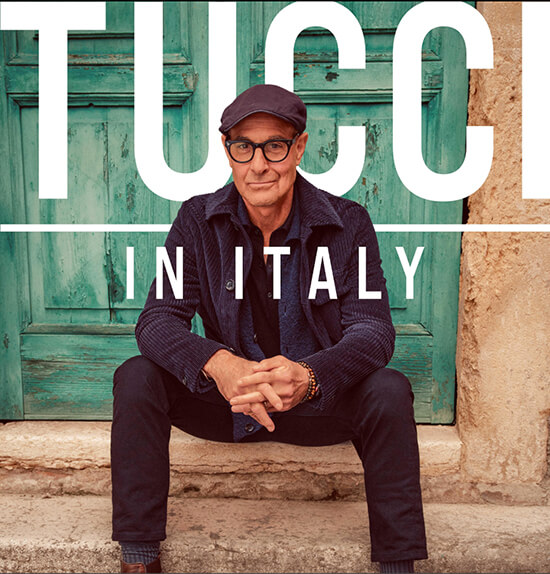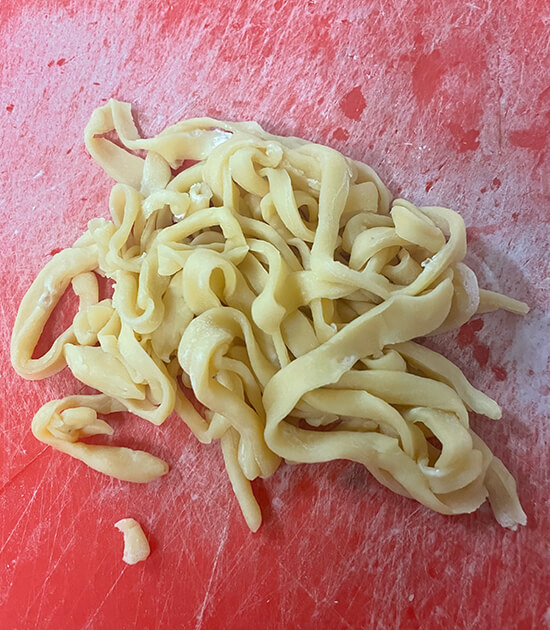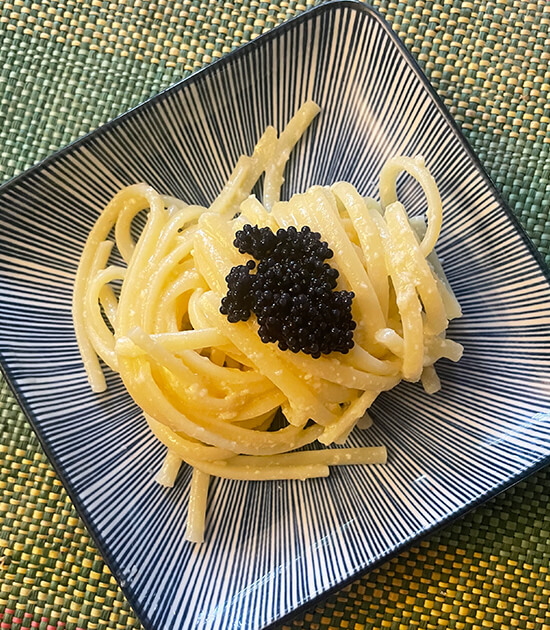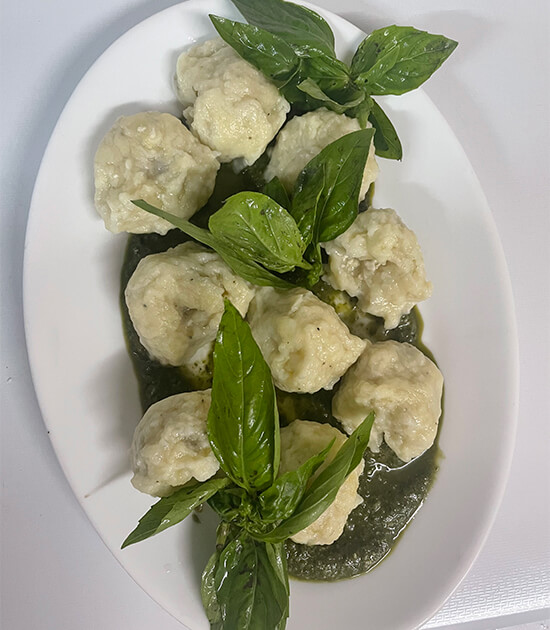Tucci’s triumphant return to Italy
Any TV watching (and book reading) I do is 99 percent food-related. After viewing episodes of The Bear, The Makanai, Selena Gomez + Chef, and other shows where the real star is gastronomy (and not celebrity), I am wont to pop into my kitchen, check the pantry, shop at the nearby grocery if needed and immediately cook what looked delicious onscreen. The members of my family are the happy recipients of this practice.
For cooks like me, one of the best-ever TV cooking shows in the world has got to be Tucci in Italy, Stanley Tucci’s second foray into Italian food culture that manages to best his first series, Searching for Italy, on CNN. I was only one of many hordes of viewers bewildered by CNN’s failure to proceed to the second season of this beloved show. Mercifully, the actor has found another streaming network to satisfy his waiting fans and we just finished watching five episodes (why only five???) on Disney+. It was well worth the wait.
I super love Stanley Tucci as an actor, especially in The Devil Wears Prada, Julie and Julia, and even, begrudgingly, in The Hunger Games where he plays the charismatic but insane-looking TV host Caesar Flickerman. But Tucci in either Searching for Italy or Tucci in Italy is truly in his element. Coming from a family of great cooks, he has also authored numerous books, including cookbooks, all of which I own save the latest one. I have cooked extensively from his cookbooks and when you follow his instructions everything comes out tasting like fine dining restaurant food. That’s why I have great respect for him as a foodie, apart from his being a charming and witty host.

Tucci in Italy begins in Tuscany, and his opening spiel against the marble quarry in the Apuan Alps village of Colonnato features brilliant cinematography. Tucci digs deep into the landscape that shapes the culture, the produce, the people and ultimately the food. The same tiny village yields that quintessential fatty product lardo, which is simply pure, unadulterated fat. It is enjoyed as such and is just one example of pristine, simple Italian ingredients that can level up to the sublime. The marble’s coldness is essential in the production of lardo; this same marble supplied the studio of Michelangelo and the columns of the Pantheon.
My takeaway from this episode is the pairing of sashimi with lemon and olive oil, a concept of chef Masaru Kawai who comes from Japan but was trained in Italy. His merging of two cuisines can be found in Cibleo Tosco-Orientale, in Florence’s Sant’Ambrogio district.
The second episode finds Tucci in Lombardy which is home to Milan, Bergamo and Brescia. From the vertical greenery of Bosco Verticale’s glass towers, to the vertical farms of Planet farms, Tucci describes Milan as a forward-thinking city in both architecture and food.
I have many takeaways from this episode, beginning with a salad of impeccable greens and herbs lightly sprayed with dressing, created by brothers Chicco and Bobo Cerea at the three-Michelin-starred Da Vittorio. The visit to a restaurant at the Autogrill, those ubiquitous road stop eateries one finds along the autostradas of Italy, yielded for me not recipes but memories of previous trips. But when Tucci visits a farm where sturgeon are sustainably raised and bites into a shrimp pasta topped with a scoop of caviar, I know I want to cook this right here, right now.

Another “must” replicate dish is risotto with Grana Padano. The cheese is exceptional, and the production of it almost died out when young Italians abandoned the dairy farms for jobs in the city. It took a generation and thousands of Punjabi immigrants, mainly Sikhs, to beautifully revive this dairy tradition with exceptional care and respect for the cows. Now, the search is on for Grano Padano! And what I have in mind is fettucine al burro, the “pure gold” created by chef Diego Rossi using only fresh pasta, butter and cheese.
In episode three, Tucci is off to the relatively obscure Trentino-Alto Adige region which borders Austria. The boundary between the people, the culture, the language and the food is less defined so that in the Michelin-starred restaurant Castel Fragsburg, Austrian knodel, or dumplings, are served right before perfect gnocchi filled with cheese. That gnocchi, which Egon Heiss painstakingly prepares before the cameras, is definitely on my to-cook list.
Episode four focuses on the region of Abruzzo, not known previously to me but very much known to my husband Roberto, who went to university in Rome when my father-in-law Sergio Barrera was ambassador to Italy. His classmate Julio had a summer house in nearby Abruzzo and watching this episode brought back memories of horseback riding in “Little Tibet,” alluding to the landscape, or searching for antiques with his parents in the mountain villages.
Most definitely, what I plan to cook from this episode is the timballo, an intricately layered dish of crepes, ragu, mini meatballs and an eggy mixture to fill the spaces with something like a souffle. I also want to recreate the elegant panzanella (bread salad), soaked in tomato broth and topped with seafood, from one of the rough but traditional fishing structures along the Trabocchi coast. Then there’s a lamb stew cooked right outdoors featuring carrots, onions, chunks of lamb and red wine. Family memories that lead to tearful remembrances also flavored this meal.
Other exceptional highlights of the visit to Abruzzo included enjoying lamb skewers in the open air, community pizza baking and how what we call Jordan almonds (“confetti” to Italians) are a lovely tradition pursued by the Pelino family.
The fifth, final and very “bitin” episode centers on Rome and its environs. Tucci discovers crisp porchetta, the Italian version of lechon, in Ariccia, 20 miles outside Rome. There are exceptional thin Roman pizzas to be had at A Rota Pizzeria in a suburb of Tor Pignattara. There is sbroscia, a rustic fish soup from Lake Bolsana elevated by the Michelin-starred restaurant La Parolina with a pesto made of basil and mint.
Watching Tucci in Italy makes me hungry for the food of the Italy of my memories, and I am glad that this incredibly gifted gourmand actor has done the research, the traveling and the tasting for us to benchmark for upcoming travels. In the meantime, I have my kitchen and all the time to whip up my take on the incredible dishes he featured, while hoping that Stanley Tucci will be given a season two, three, four and more. The world’s palates will be thankful for it.
Here are the dishes I cooked out of the show, I hope you enjoy them as much as we did!
Recipe file
Fresh Pasta

Make a mound on the counter with:
- 1 cup flour
- Make a well in the center and add:
- 1 tsp. salt
- 1 Tbsp. olive oil
- 2 eggs
Carefully work the flour into the eggs to form a dough; knead until smooth adding a teaspoon of water if there are any dry bits. Divide into two parts, cover and let rest 10 minutes. If you don’t have a pasta machine, roll them out paper-thin (the resting is important for this) and roll them up, dusting with flour as needed. Cut the rolls into strips and unroll. Boil immediately in salted water for a few minutes, or till they rise to the top, or refrigerate the uncooked pasta for later use.
Fettucine Al Burro Con Caviar

Combine freshly cooked pasta with good salted butter, grated parmesan cheese (Grana Padana if you’re lucky enough to find it), pepper and enough pasta water to make a creamy sauce. Twirl with a fork into small portions and top each with a spoon of caviar.
Mint and Basil Pesto
In the show, it is stressed that this pesto is made without garlic and the flavor is a revelation. Blend together in a food processor or blender:
- 1 cup basil leaves
- ¼ cup mint leaves
- ¼ cup pine nuts (available at Santi’s and Landers)
- ½ cup extra virgin olive oil
- ½ tsp. pepper
- When finely blended stir in:
- ½ cup parmesan cheese
Taste to see if it needs extra salt.
- Pomodoro Crudo for Panzanella and Sbroscia
I made an uncooked tomato sauce (pomodoro crudo) by blanching and de-seeding a kilo of fresh tomatoes, blending them with ¼ tsp. each salt and pepper and 2 Tbsp. extra virgin olive oil.
For the panzanella, dip chunks of French or sourdough bread in the pomodoro crudo then lightly brown in olive oil. Serve topped with seafood and basil leaves.
For the sbroscia, I poached scallops and prawns in the pomodoro crudo just until they were done. The seafood is what flavors the broth.
Gnocchi

Following chef Egon Heiss, I boiled potatoes then peeled and mashed them while still hot. I blended 4 potatoes with 2 eggs and about 1 cup flour, and ¼ tsp. each salt and pepper to make a slightly sticky dough. I shaped the ¾-inch balls of dough around cubes of ripe Brie and put them in the freezer to firm up before cooking them in salted water. I served them over a bed of the mint and basil pesto, as in the show the gnocchi were plated on a green sauce of herbs.
Timballo

This is worth the effort! It’s like a light version of lasagna. You layer crepes, ragu or pomodoro sauce, mini meatballs and a mixture of beaten eggs, milk and parmesan cheese.
For the meatballs, I combined ¼ kilo ground beef, 2 Italian sausages from Santi’s (remove the casing), 2 slices French bread soaked in milk, an egg and ½ tsp. each salt, pepper and oregano. Shape into ½-inch meatballs and fry till golden. They are delicious by themselves!


